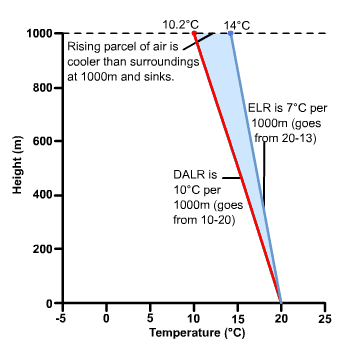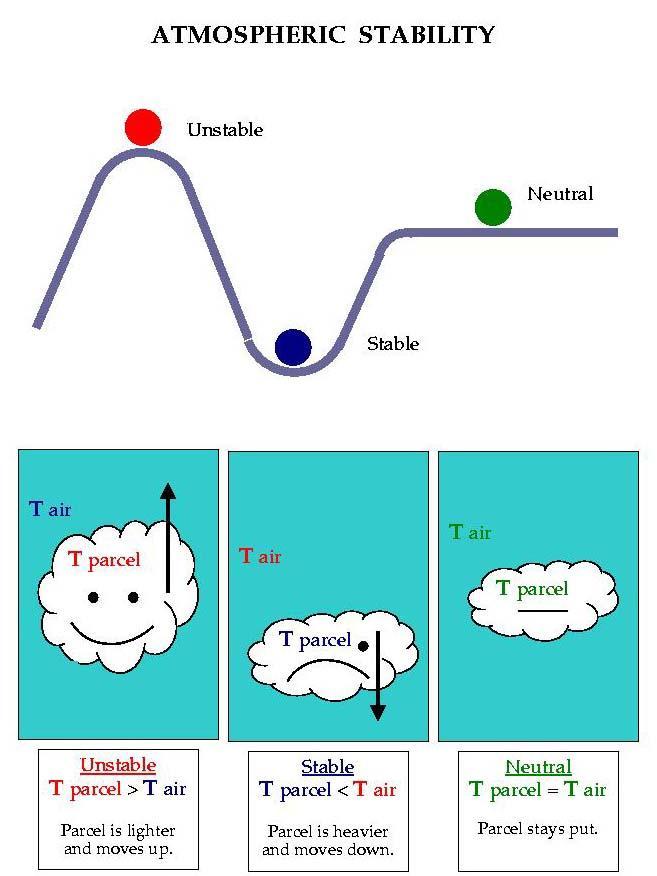Explain how the relationship between the ELR and DALR can be used to determine the stability or instability of unsaturated air.
A stable situation is confirmed when the DALR lies below the ELR
The air is unstable when the DALR lies above the ELR

In this situation, the DALR is below the ELR, meaning that the air is stable.
State the dry adiabatic lapse rate (DALR).
DALR = 3 degrees Celsius per 1000 ft
Picture a parcel of air being forced to rise up the slope of a hill.
As it enters higher levels where the pressure is less, the parcel expands and then cools adiabatically. The rate at which this cooling takes place is about 3 degrees per 1000ft.
This rate applies to all parcels of rising or descending air provided the water vapour within it does not condense – ie air must remain “dry”

Interpret graphs of steep and shallow environment lapse rates (ELR) including inversions and isothermal layers.
Steep ELR
A large decrease in temperature with height
ie found in the lower layers of the atmosphere on a hot summer’s day
Shallow ELR
This is a small decrease in temperature with height – eg in air over the sea which does not warm greatly at low levels

Explain the adiabatic process;
When a parcel of air is forced to rise through the atmosphere its internal temperature decreases
– with rising there is less pressure
– which causes it to expand,
– followed by cooling
Because the air molecules are cooler, they have more room to move about so they collide less frequently and therefore generate less heat – this process is the ADIABATIC PROCESS
The second lapse rate occurs when the parcels of air rise or descend, so that their volumes change as the pressure around them changes
The process involved is the Adiabatic process
A change in temperature, takes place while no heat energy is given to or taken from the surroundings
Explain how the environmental temperature and dew point lapse rates are found;
These measurements are derived from data from a weather balloon aloft, which carries an electronic instrument package called a “radiosonde”
Temperature, dew point and pressure are measured every minute’ then the data is radioed back to a ground station
The data gathered is then plotted on a graph called a Tephigram
Additional data can be gathered from aircraft and satellites
Describe what is meant by "environmental lapse rate" (ELR).
The Environmental Lapse Rate (ELR)
is the rate of decrease of temperature with altitude in the stationary atmosphere at a given time and location.
The average ELR is around 2 deg per 1000 ft as per ISA standard
Thins can change quickly over time and vertical distance with increasing temperature with increasing height (inversions) and isothermal layers
For example;
International standard atmosphere (ISA) has a Environmental lapse rate of 1.98 °C/1,000 ft,
often round to 2 °C/1,000 ft.
| Altitude |
Temperature |
| Sea Level |
15 °C
|
| 1000 ft |
13 °C |
| 2000 ft |
11 °C |
| 3000 ft |
9 °C |
| etc .. |
|
State the two factors that determine the stability of air.
Whether the air is stable or unstable depends mainly on these two factors:
The temperature lapse rate of..
large air masses or the Environmental.
The adiabatic lapse rate
as a parcel (balloon) of air moves up it cools.
Stable
If parcel of air is colder than the environment. then parcel will sink or return to down to original location.
Unstable
If parcel of air is warmer than the environment. then parcel will continue to rise.
Describe how the stability of a rising or sinking parcel of air is determined by its temperature compared with the temperature of the surrounding environment;
If the temperature inside the parcel of air becomes warmer than the surrounding environment during lifting it will continue to rise when the lifting force ceases because the air inside is less dense ie; entering an unstable atmosphere
If the air inside the parcel becomes colder than the environment during the lift the parcel will sink when the lifting force ceases because it will be denser ie; risen into a stable atmosphere
The temperature changes within a rising parcel of air are not necessarily the same as those temperature changes in the surrounding environment
Explain what is meant by:
a) stable air;
b) unstable air;
c) neutrally stable air.
a) Stable Air
Air is considered stable when a parcel of air is forced up or down from its current position or height, and without assistance from other outside influences, returns to its original position.
b) Unstable Air
If a parcel of air has no tendency to return to it’s original position after a disturbance, and instead moves further away it is said to be unstable.
c) Neutrally stable air
If following a disturbance a parcel of air has no tendency to return to original position or move further away it is said to be neutrally stable

Explain how temperature, relative humidity and Dew Point values can be used to indicate differences in water content of air.
Relative Humidity and Dew Point are useful and practical indicators of the “dampness ” of air and the likelihood of cloud / fog formation and precipitation.
VFR flying can be more difficult / unsafe if the resulting cloud base is very low.

